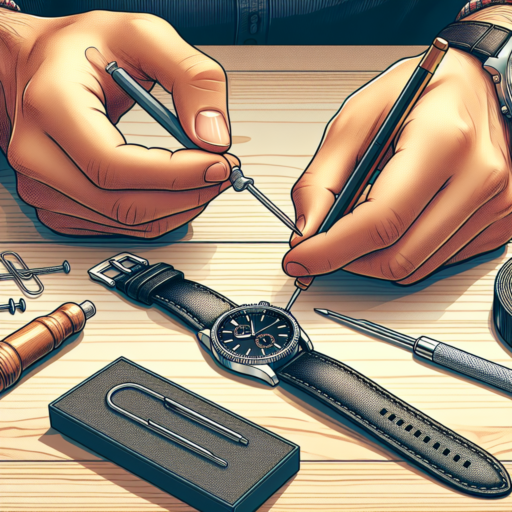How do I take my watch band off?
Taking off your watch band might seem like a daunting task, particularly if you’re doing it for the first time or if you have a new watch with a different type of band. However, the process can be straightforward once you understand the mechanism behind the band attachment. Whether it’s a metal link bracelet, a leather strap, or a sporty silicone band, the key is to approach the task with care to avoid damaging your watch or the band.
Most watch bands are attached to the watch case through spring bars or pins that fit into holes on the watch lugs. To remove the band, you will generally need to release these spring bars or pins. For metal link bracelets, it’s often necessary to use a small tool, such as a spring bar tool or a small screwdriver, to carefully push in one end of the spring bar until it releases from the lug. With leather or silicone straps, the process might also involve manipulating a small buckle or clasp. However, some straps come equipped with a quick-release mechanism that allows you to easily swap bands without any tools.
Here are some simple steps to follow when attempting to take off your watch band:
- Prepare a clean, soft surface to work on – this will help prevent scratches.
- If necessary, use the right tool for your type of watch band – a spring bar tool for metal bracelets or a small pin pusher for bands with pins.
- Carefully locate the spring bars or pins that secure the band to the watch lugs.
- Apply gentle pressure to the spring bar or pin until it releases, then slowly detach the band from the watch case.
Keep in mind that the process can vary slightly depending on the type of watch band and the manufacturer’s specific design. If you’re unsure or unable to easily remove the band, it’s always a safe option to consult with a professional watchmaker or the manufacturer’s instructions to avoid causing any unintended damage to your watch.
How to remove a watch band without a tool?
Removing a watch band without the proper tools might seem like a daunting task at first. However, with a bit of patience and some household items, you can easily perform this task without the need for specialized tools. Whether you’re looking to replace your watch band or simply want to clean it, learning this technique can prove to be quite handy.
Using a Paper Clip or Toothpick
One of the simplest methods to remove a watch band involves using a straightened paper clip or a sturdy toothpick. First, locate the spring bar—a small cylindrical bar that holds the band in place. Gently insert the paper clip or toothpick into the hole or notch where the spring bar is visible. Press firmly but carefully until you feel the spring bar compress, then slowly maneuver the watch band away from the watch case. This technique requires a soft hand to avoid scratching your watch.
Utilizing a Credit Card or a SIM Card Tool
An alternative method for those uncomfortable using sharp objects near their watch is to use the corner of a credit card or a SIM card tool. This method works best with watches that have a small gap between the band and the case. Carefully slide the corner of the card into this gap and gently wiggle it to compress the spring bar. Once you feel the bar give way, you can ease the band out from one side and then repeat the process on the other side. This method is particularly useful for avoiding potential scratches to your watch’s surface.
While these techniques can be effective, always proceed with caution to avoid damaging your watch. If at any point you feel uncomfortable or unable to remove the band safely, consulting a professional watchmaker or jeweler is advisable. With a little practice, removing a watch band without a tool can become a straightforward and hassle-free task.
No se han encontrado productos.
How to remove watch strap metal?
Removing a metal watch strap may seem daunting at first, but with the right tools and a bit of know-how, it’s a task you can accomplish at home. Whether you’re looking to swap your strap for a new look, adjust the size, or perform maintenance, this guide will walk you through the essential steps.
Tools You Need
Before you start, ensure you have the appropriate tools on hand. A small flathead screwdriver or a watch pin removal tool is crucial for most watches. For many watch enthusiasts, a small hammer and a pair of precision tweezers can also prove invaluable in facilitating the removal process.
Step-by-Step Guide
- Identify the Pins or Screws: Start by locating the pins or screws that hold your watch strap in place. Most metal straps are secured with spring bars that you’ll need to depress to release the strap.
- Depress the Spring Bar: Carefully position your tool against the spring bar’s ridge or notch. Apply gentle pressure to depress the bar. You may need to wiggle the tool slightly to fully disengage the spring bar from its seat.
- Remove the Strap: Once the spring bar is depressed, gently pull the strap away from the watch case. Repeat on the other side of the strap if necessary. Take this opportunity to clean any debris that may have accumulated around the watch’s lug area.
With patience and the right technique, removing a metal watch strap can be straightforward. Remember to work over a soft, clean surface to prevent any damage to your watch should you accidentally drop it or to lose any small components during the process.
Which way does a watch clasp go?
Understanding the correct orientation of a watch clasp is crucial for both the comfort and the aesthetic of wearing a watch. It’s a question that might seem straightforward, but it holds importance for ensuring your watch fits securely and looks its best on your wrist.
Correct Positioning of the Watch Clasp
The standard position for a watch clasp is underneath the wrist. This means when you put on your watch, the clasp should fasten on the side of your wrist that faces the ground. This orientation is not just about aesthetics; it helps in evenly distributing the watch’s weight around your wrist, providing a comfortable fit that avoids unnecessary strain.
In addition to comfort, proper clasp orientation ensures the longevity of both the watch band and the clasp mechanism itself. By wearing the watch as intended, you minimize the wear and tear on these components, helping to keep your watch in prime condition over time.




